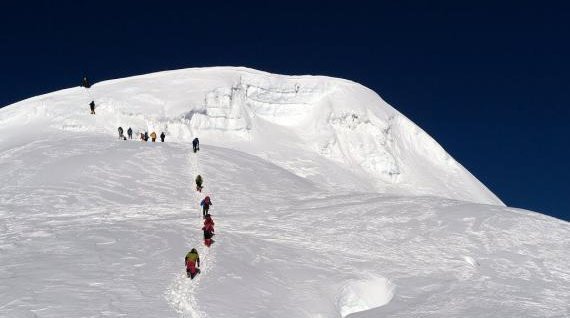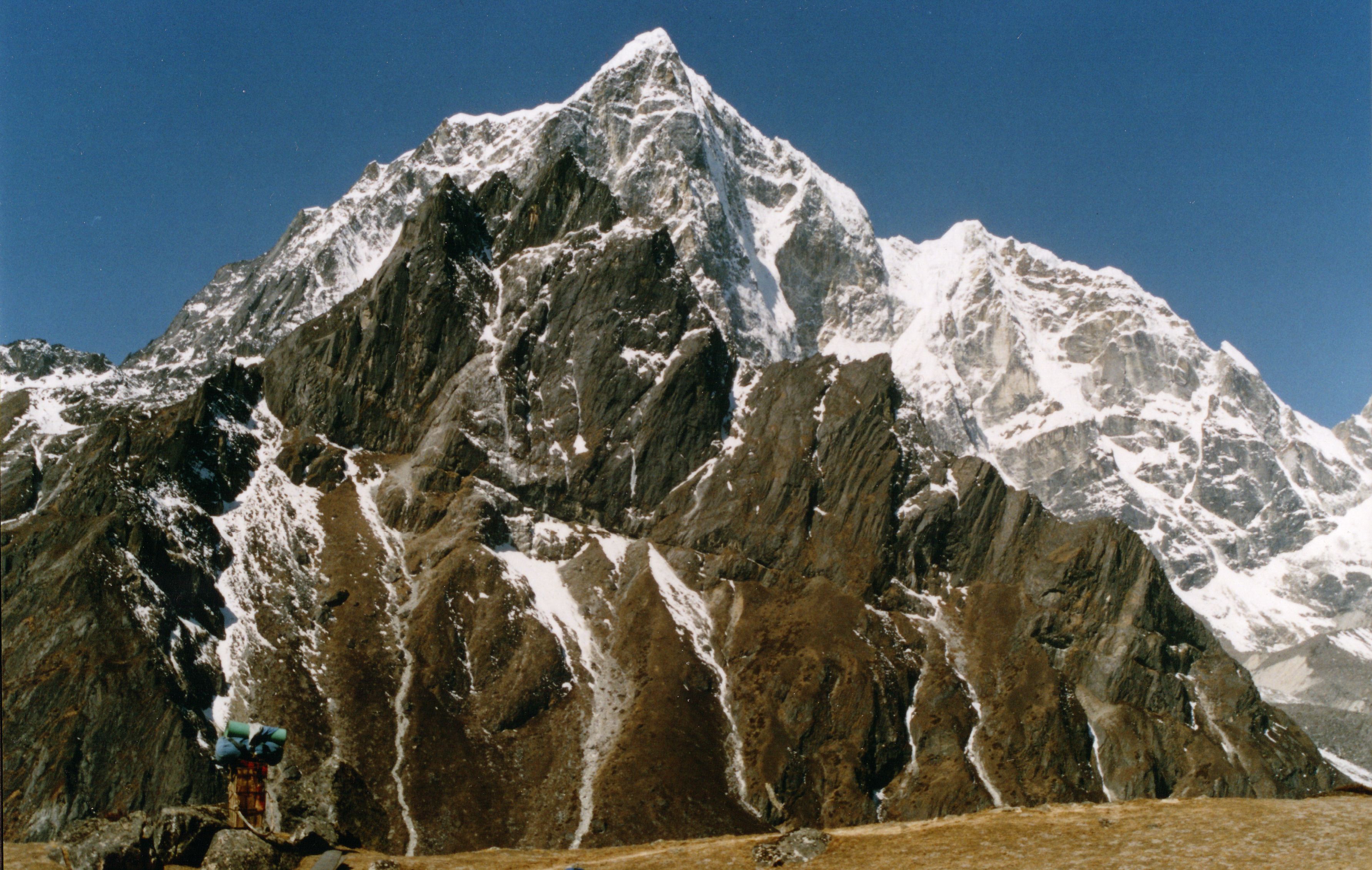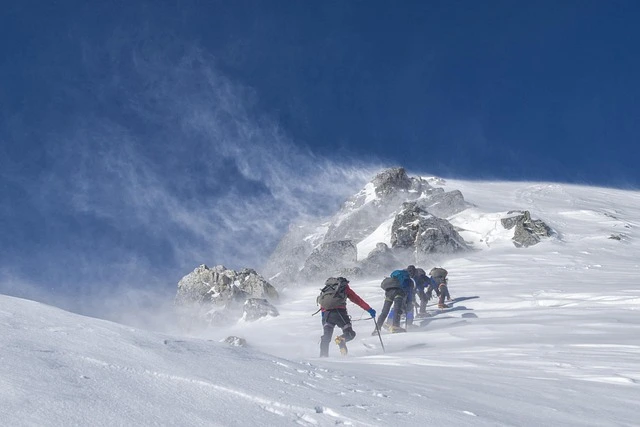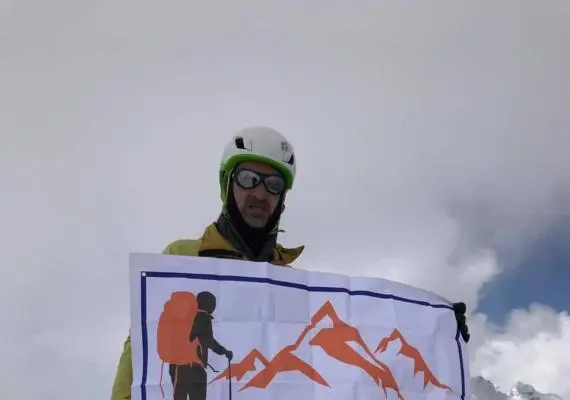Standing at 6,476 meters, Mera Peak beckons as Nepal's highest trekking peak—a thrilling gateway to high-altitude mountaineering. From its snow-capped summit, witness breathtaking views of Everest, Lhotse, and Makalu while experiencing the authentic culture of remote Sherpa villages. This comprehensive Mera Peak Climbing guide reveals everything you need to transform your Himalayan dreams into reality.
Our all-inclusive $8500 package delivers 16 days of expertly guided adventure, combining professional mountaineering support with cultural immersion. Whether you're taking your first steps into high-altitude climbing or seeking your next summit challenge, this guide provides your complete roadmap to success.
Ready to embark on the adventure of a lifetime? Discover everything you need to know below and secure your spot on Nepal's most rewarding trekking peak.
Mera Peak Climbing Trip Highlights
Your Mera Peak adventure delivers an extraordinary combination of mountaineering achievement and cultural discovery. At 6,476 meters, you'll stand atop Nepal's highest trekking peak, gazing across a 360-degree panorama featuring five of the world's fourteen eight-thousanders. The journey takes you through the remote Hinku Valley, far from tourist crowds, where traditional Sherpa life continues unchanged.
Key Expedition Highlights:
- Summit Achievement: Reach 6,476m with sunrise views over Everest, Lhotse, Makalu, Cho Oyu, and Kanchenjunga
- Remote Adventure: Trek through pristine Hinku Valley with authentic cultural experiences
- Professional Support: Expert guides with 10+ years experience and 1:2 guide-to-climber ratio on summit day
- Skill Development: Learn glacier travel, crampon techniques, and basic mountaineering skills
- All-Inclusive Value: $8500 covers permits, guides, accommodation, meals, and equipment
- Flexible Difficulty: Suitable for fit beginners with basic mountaineering enthusiasm
- Small Groups: Maximum 8 climbers ensuring personalized attention
- Safety First: Comprehensive protocols including satellite communication and emergency evacuation plans
This 16-day Mera Peak expedition perfectly balances challenge with accessibility, making high-altitude dreams achievable while providing authentic Nepal trekking experiences that create lifelong memories.
Why Choose Mera Peak for Your Himalayan Adventure?
Mera Peak stands out as the ideal choice for your Himalayan climbing experience, offering an unmatched combination of accessibility, stunning views, and cultural authenticity. Unlike technical peaks that require extensive climbing experience, Mera Peak welcomes fit adventurers ready to take their first steps into high-altitude mountaineering.
Accessibility for Aspiring Mountaineers
The beauty of Mera Peak lies in its non-technical nature. While you'll need basic crampon and ice axe skills, our expert guides provide comprehensive training throughout the journey. The gradual acclimatization schedule ensures your body adapts naturally to the altitude, with multiple practice sessions building your confidence before summit day. This makes Mera Peak the perfect stepping stone for trekkers transitioning into mountaineering.
World-Class Summit Views
Few peaks in the world offer such spectacular summit panoramas. On a clear day, you'll witness five of the world's highest mountains:
- Mount Everest (8,849m) dominating the northern horizon
- Lhotse (8,516m) standing shoulder-to-shoulder with Everest
- Makalu (8,485m) rising dramatically to the east
- Cho Oyu (8,188m) marking the Tibet border
- Kanchenjunga (8,586m) visible in the distant east
The sunrise from Mera Peak summit creates an unforgettable spectacle as golden light illuminates the entire Himalayan range, making every step of your Nepal trekking peak journey worthwhile.
Authentic Cultural Experience
Your Mera Peak adventure takes you far from crowded tourist trails into the heart of traditional Sherpa culture. The remote Hinku Valley preserves authentic village life, where prayer flags flutter above stone houses and yak herds graze in high pastures. You'll experience genuine hospitality in local teahouses, visit ancient Buddhist monasteries, and gain insights into a way of life unchanged for centuries.
Perfect Training Ground
Mera Peak serves as an excellent introduction to Himalayan climbing, teaching essential skills including:
- Glacier travel and crevasse awareness
- Fixed rope techniques
- High-altitude camping strategies
- Weather assessment and decision-making
- Team dynamics in challenging conditions
These experiences prepare you for future expeditions while providing the satisfaction of a significant summit achievement.
Mera Peak Climbing Itinerary Overview (16 Days)
Our carefully crafted 16-day Mera Peak itinerary balances proper acclimatization with summit success, ensuring you're physically and mentally prepared for the challenge ahead. The journey combines scenic trekking through remote valleys with progressive altitude gains, culminating in your summit attempt.
Journey Breakdown:
Days 1-2: Kathmandu to Lukla, Trek to Paiya (2,730m) Your adventure begins with an exhilarating flight to Lukla's mountain airstrip, followed by a gentle trek through terraced fields and traditional villages. This initial phase allows your body to adjust while immersing you in local culture.
Days 3-5: Trek to Hinku Valley (3,500m) Crossing the Pangkongma La pass marks your entry into the remote Hinku region. The trail winds through rhododendron forests and past scattered settlements, gradually revealing the spectacular mountain scenery ahead.
Days 6-7: Valley Exploration and Acclimatization (4,200m) These crucial acclimatization days combine gentle hikes with cultural experiences. You'll visit local monasteries, interact with Sherpa families, and enjoy your first close views of Mera Peak.
Days 8-9: Trek to Khare Base Camp (5,045m) The approach to Mera Peak base camp brings dramatic landscape changes as you enter the alpine zone. Training begins here with crampon practice and rope work on nearby slopes.
Days 10-11: Acclimatization and Training at Khare Dedicated training days ensure everyone masters essential mountaineering skills. Practice sessions on the glacier build confidence while acclimatization hikes prepare your body for higher altitudes.
Day 12: Establish High Camp (5,780m) The move to high camp crosses the Mera Glacier, offering real mountaineering experience. This strategic position minimizes summit day effort while maximizing acclimatization benefits.
Day 13: Summit Day - Mera Peak (6,476m) Starting at 2 AM under starlit skies, you'll climb steadily toward the summit. The non-technical route still demands endurance as you navigate snow slopes to reach the top for a spectacular sunrise.
Days 14-16: Descent to Lukla The return journey allows time to reflect on your achievement while enjoying different perspectives of the landscape. Celebration dinners in local villages mark the successful completion of your Mera Peak expedition.
Essential Preparation for Mera Peak Climbing
Success on Mera Peak depends significantly on thorough preparation. While the climb doesn't require technical expertise, the altitude and physical demands necessitate serious training and mental readiness. Starting your preparation 3-6 months before departure ensures you'll enjoy the journey rather than simply endure it.
Physical Fitness Requirements
Mera Peak climbing demands excellent cardiovascular fitness and muscular endurance. You'll be trekking 5-8 hours daily at progressively higher altitudes, culminating in a 10-12 hour summit day. Your training should focus on:
Cardiovascular Training:
- Build a strong aerobic base with regular hiking, running, or cycling
- Aim for 4-5 training sessions weekly
- Include one long endurance session (4-6 hours) each week
- Practice hiking with a weighted backpack (10-15kg)
- Incorporate stair climbing or hill repeats for leg strength
Strength Training:
- Focus on leg strength: squats, lunges, step-ups
- Core stability exercises for balance on uneven terrain
- Upper body strength for using trekking poles and ice axe
- Flexibility training to prevent injuries
Altitude Acclimatization Strategy
Our Mera Peak itinerary includes built-in acclimatization days, but understanding altitude adaptation helps you prepare mentally and physically. Key principles include:
- Gradual altitude gain following the "climb high, sleep low" principle
- Staying hydrated (3-4 liters daily)
- Eating regularly despite decreased appetite
- Monitoring your body's response to altitude
- Communicating any symptoms to your guide immediately
Mental Preparation
The psychological aspects of Mera Peak climbing often prove as challenging as the physical demands. Summit day requires mental fortitude to push through fatigue and cold in the pre-dawn darkness. Visualization techniques, meditation practice, and setting realistic expectations all contribute to summit success.
Building mental resilience involves understanding that discomfort is temporary and focusing on the incredible achievement awaiting you. Many successful climbers report that breaking the journey into smaller, manageable segments helps maintain motivation throughout the expedition.
Complete Gear and Equipment Guide
Proper equipment is crucial for safety and comfort during your Mera Peak adventure. While our $8500 package includes group climbing equipment, personal gear selection significantly impacts your experience. Nepal's extreme altitude and weather conditions demand quality equipment that performs reliably.
Essential Climbing Gear
Technical Equipment (can be rented in Kathmandu):
- Mountaineering boots (insulated, crampon-compatible)
- Crampons (12-point, fitted to your boots)
- Ice axe (60-70cm general mountaineering)
- Climbing harness with adjustable leg loops
- Carabiners (2 locking, 2 non-locking)
- Helmet for summit day
Personal Climbing Gear:
- Down jacket (800+ fill, rated to -20°C)
- Insulated climbing pants
- Base layers (merino wool or synthetic)
- Mid-layers for temperature regulation
- Hardshell jacket and pants (waterproof/breathable)
- Insulated gloves plus liner gloves
- Warm hat and sun hat
- Buff or balaclava
- Glacier glasses (Category 4)
Trekking Equipment Essentials
Your daily trekking comfort depends on quality basics:
- Trekking boots (broken in, waterproof)
- Daypack (30-40 liters)
- Sleeping bag rated to -20°C
- Trekking poles (collapsible)
- Headlamp with extra batteries
- Water bottles or hydration system (3-liter capacity)
- Personal first aid kit and medications
Equipment Rental Options
Kathmandu offers extensive rental options for technical gear, saving significant luggage space and cost. Quality varies between shops, so we recommend:
- Renting boots only if you cannot purchase proper ones
- Testing all rental equipment before departure
- Bringing personal items that affect comfort (gloves, socks, base layers)
- Budgeting $200-300 for quality rentals if needed
Mera Peak Climbing Cost Breakdown ($8500)
Understanding what your $8500 investment includes helps appreciate the comprehensive nature of our Mera Peak climbing package. This all-inclusive price covers every essential aspect of your expedition, ensuring you can focus entirely on the climbing experience without hidden costs or surprises.
What's Included in Your Package:
Professional Guide Services:
- IFMGA/NNMGA certified climbing guide
- Assistant guides (1:4 ratio)
- Dedicated summit guide (1:2 ratio)
- Pre-climb training and daily briefings
- 24/7 support throughout expedition
Permits and Documentation:
- Mera Peak climbing permit ($250 value)
- Makalu Barun National Park fees
- TIMS card (Trekkers' Information Management System)
- Garbage deposit and local area fees
- All government taxes
Accommodation and Meals:
- Kathmandu hotel (3 nights with breakfast)
- Tea house accommodation during trek
- High-quality mountain tents above base camp
- All meals during trek (breakfast, lunch, dinner)
- Hot drinks and snacks
- Welcome and farewell dinners
Logistics and Transportation:
- Kathmandu-Lukla-Kathmandu flights
- Airport transfers
- Porter services (up to 15kg personal gear)
- Group climbing equipment (ropes, anchors)
- First aid kit and emergency oxygen
- Satellite phone for emergencies
Value Comparison
When comparing Mera Peak climbing costs across operators, consider that bargain prices often compromise safety or comfort. Our $8500 investment ensures:
- Experienced, certified guides (not just assistants)
- Proper insurance for all staff
- Quality food maintaining energy at altitude
- Genuine safety equipment and protocols
- Sustainable wages supporting local communities
This transparent pricing means no surprise charges for "extras" like rope fixing, crampon rental for group equipment, or emergency evacuations coordination—elements some operators charge additionally.
Permits and Documentation Required
Navigating Nepal's permit requirements can be complex, but our team handles all bureaucratic processes as part of your package. Understanding these requirements helps you prepare necessary documents before arrival.
Essential Permits:
Mera Peak Climbing Permit:
- Issued by Nepal Mountaineering Association (NMA)
- Spring season (March-May): $250
- Autumn season (September-November): $125
- Requires passport copy and photos
- Processed through authorized agencies only
Makalu Barun National Park Entry:
- Covers conservation area access
- Foreign nationals: NPR 3,000
- SAARC nationals: NPR 1,500
- Supports park conservation efforts
TIMS Card Requirements:
- Mandatory for all trekkers in Nepal
- Provides emergency tracking capability
- Requires passport copy and photos
- Valid for single entry only
Visa and Immigration:
Nepal offers visa on arrival for most nationalities:
- 15-day visa: $30
- 30-day visa: $50
- 90-day visa: $125
- Requires passport valid for 6 months
- Two passport photos needed
- Cash payment in USD preferred
Insurance Requirements:
Comprehensive travel insurance is mandatory, covering:
- Emergency evacuation to 6,500m minimum
- Medical treatment and repatriation
- Trip cancellation/curtailment
- Lost baggage and delays
- Adventure sports coverage explicitly including "mountaineering"
We recommend providers specializing in high-altitude expeditions, as standard travel insurance often excludes activities above 4,000m.
Best Time to Climb Mera Peak
Choosing the optimal season for your Mera Peak expedition significantly impacts your experience and summit success chances. Nepal's mountain weather follows predictable patterns, with two distinct climbing seasons offering different advantages.
Spring Season (March-May)
Spring represents the traditional climbing season in Nepal, coinciding with major Everest expeditions. The season offers:
Advantages:
- Stable weather patterns with minimal precipitation
- Warmer temperatures, especially at lower altitudes
- Rhododendron forests in full bloom
- Clear mountain views before monsoon haze
- Longer daylight hours for summit attempts
Considerations:
- More crowded trails and tea houses
- Higher permit costs
- Potential for afternoon clouds
- Avalanche risk from winter snow accumulation
Autumn Season (September-November)
Post-monsoon autumn delivers Nepal's clearest weather, making it ideal for photography and views:
Advantages:
- Crystal-clear mountain vistas
- Stable high-pressure systems
- Festive atmosphere during Dashain/Tihar
- Lower permit fees
- Well-consolidated snow conditions
Considerations:
- Colder temperatures, especially at night
- Shorter daylight hours
- Potential early winter storms in November
- Busier tourist season overall
Weather Patterns and Temperatures
Understanding typical conditions helps with preparation:
Base Camp (5,000m):
- Day: 5°C to -5°C
- Night: -10°C to -15°C
High Camp (5,780m):
- Day: -5°C to -10°C
- Night: -15°C to -20°C
Summit (6,476m):
- Typical: -20°C to -25°C
- Wind chill can reach -30°C
Choosing Your Season
For first-time climbers, we recommend spring for warmer conditions and longer days. Experienced mountaineers might prefer autumn's stability and clearer views. Both seasons offer excellent summit success rates with proper preparation.
Safety Measures and Risk Management
Your safety remains our absolute priority throughout the Mera Peak expedition. Our comprehensive risk management protocols, developed over years of guiding experience, address the inherent challenges of high-altitude mountaineering while maximizing your summit chances.
Altitude Sickness Prevention
Altitude-related illness poses the primary risk on Mera Peak. Our prevention strategy includes:
Acclimatization Protocol:
- Gradual altitude gain (maximum 500m sleeping elevation per day above 3,000m)
- Rest days at 4,200m and 5,000m
- "Climb high, sleep low" practice hikes
- Daily health monitoring using pulse oximeters
- Immediate descent if severe symptoms develop
Early Warning Signs We Monitor:
- Headache patterns and severity
- Sleep quality and appetite changes
- Energy levels and coordination
- Blood oxygen saturation levels
- Decision-making capability
Emergency Protocols
Despite careful planning, emergencies can occur. Our response system ensures rapid, effective action:
Communication Systems:
- Satellite phone for weather updates and emergencies
- Radio communication between guide teams
- Daily check-ins with base operations
- GPS tracking devices for all groups
Evacuation Procedures:
- Helicopter evacuation coordination from multiple points
- Established landing zones throughout the route
- Insurance verification before departure
- Medical kit with altitude medications
- Oxygen system for emergencies
Guide Qualifications and Experience
Your safety depends on expert leadership. Our guides bring:
- IFMGA or NNMGA certification
- Minimum 10 years Himalayan experience
- Wilderness first responder training
- Specific Mera Peak expertise (20+ summits)
- English fluency for clear communication
- Cultural sensitivity and local knowledge
Weather Monitoring and Decision Making
Summit success requires balancing ambition with prudent decision-making:
- Professional weather forecasting service
- Multiple weather models consultation
- Flexible summit windows
- Conservative turn-around times
- Group consensus on major decisions
Our 85% summit success rate reflects this careful approach, prioritizing your safety while maximizing opportunities for success on this Nepal trekking peak.
Cultural Insights and Responsible Trekking
Your Mera Peak journey traverses sacred landscapes where mountains hold deep spiritual significance. Understanding and respecting local culture enriches your experience while supporting communities who've called these valleys home for generations.
Sherpa Culture and Traditions
The Sherpa people, renowned for their mountaineering prowess, maintain rich cultural traditions:
Religious Practices:
- Buddhism shapes daily life and mountain perspectives
- Prayer wheels, mani stones, and stupas mark the trail
- Mountains are sacred deities requiring respect
- Clockwise circumambulation around religious sites
- Prayer flags carry blessings on the wind
Cultural Etiquette:
- Remove shoes before entering homes or monasteries
- Accept tea and food offerings graciously
- Dress modestly, especially in villages
- Ask permission before photographing people
- Avoid pointing feet at people or religious objects
Responsible Trekking Practices
Preserving the Himalayan environment requires conscious effort from every visitor:
Environmental Guidelines:
- Pack out all non-biodegradable waste
- Use designated toilet facilities where available
- Avoid single-use plastics (bring reusable bottles)
- Stay on established trails
- Respect wildlife and maintain distance
Supporting Local Communities:
- Purchase handicrafts directly from artisans
- Eat local foods in tea houses
- Hire local porters at fair wages
- Contribute to community projects
- Learn basic Nepali phrases
Cultural Highlights Along the Route
Your trek offers numerous cultural encounters:
- Lukla: Gateway bustling with expedition energy
- Buddhist Monasteries: Ancient centers of learning and meditation
- Mani Walls: Sacred stones carved with prayers
- Traditional Villages: Stone houses with carved wooden windows
- Yak Herders: Seasonal camps in high pastures
Understanding that you're a guest in these communities fosters meaningful connections and ensures tourism benefits local people while preserving their remarkable culture.
Conclusion
Your Mera Peak climbing adventure represents more than just reaching 6,476 meters—it's a transformative journey through Nepal's most spectacular landscapes, immersing you in authentic Sherpa culture while achieving a significant mountaineering goal. This comprehensive Mera Peak Climbing guide has equipped you with essential knowledge for planning your expedition.
Our all-inclusive $8500 package removes the complexity from organizing your dream adventure. With expert guides, proven safety protocols, and comprehensive support, you can focus on the incredible experience ahead. From your first glimpse of the Himalayas to standing atop Nepal's highest trekking peak watching sunrise over Everest, every moment creates lasting memories.
The journey to Mera Peak summit challenges you physically and mentally while rewarding you with unparalleled mountain vistas and personal achievement. Whether you're taking your first steps into high-altitude mountaineering or seeking your next adventure, Mera Peak offers the perfect blend of accessibility and accomplishment.





